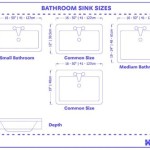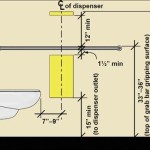Why Is There A Sewage Smell Coming From Your Bathroom Sink?
A foul, sewage-like odor emanating from a bathroom sink is a common and unpleasant plumbing problem that can plague any home. The scent is not only offensive but also indicative of an underlying issue within the drain system. Identifying the source of the odor is crucial to addressing the problem and restoring a sanitary and odor-free bathroom. This article will explore the common causes of this issue, outlining potential problems and offering possible solutions.
The presence of a sewage smell suggests that noxious gases, primarily hydrogen sulfide, methane, and ammonia, are escaping from the drainage pipes. These gases are byproducts of the decomposition of organic matter within the plumbing system. Normally, these gases are safely vented out of the building through the vent stack, a vertical pipe that extends upwards from the drainage system through the roof. When this venting system fails or is compromised, the gases can find their way back into the living space, often through the weakest points in the system, such as the bathroom sink drain.
Several potential factors can contribute to the sewage smell. It is important to methodically examine each possibility to determine the root cause and implement the correct corrective action. Ignoring the problem can lead to health concerns because the gases can cause headaches, nausea, and in severe cases, even more serious respiratory problems. Prolonged exposure to these gases is not advisable, particularly for vulnerable individuals such as children, the elderly, or those with pre-existing respiratory conditions.
The Dry P-Trap: A Common Culprit
One of the most frequent reasons for a sewage smell originating from a bathroom sink is a dry P-trap. The P-trap is the curved section of pipe located under the sink. Its primary function is to hold a small amount of water, which acts as a barrier, preventing sewer gases from rising up through the drain and into the bathroom. This water seal effectively traps the gases and stops them from entering the living space. When the water in the P-trap evaporates, this barrier is lost, and the gases can then freely flow back up through the drain.
The evaporation of water in the P-trap is most common in infrequently used sinks, such as those in guest bathrooms or vacation homes. When the sink is not used regularly, the water in the trap gradually evaporates over time. Another potential, but less common, cause of a dry P-trap is a leak in the trap itself. Even a small leak can slowly drain the water, eventually compromising the water seal. Checking for any visible signs of leakage around the P-trap area can help rule out this possibility.
The solution to a dry P-trap is relatively simple: running water down the drain for a few minutes will refill the trap and restore the water seal. If the odor persists after refilling the trap, it indicates that there may be another underlying issue or that the P-trap is leaking and needs to be repaired or replaced. It is also advisable to periodically run water down drains that are not frequently used to prevent the P-trap from drying out. Pouring a small amount of mineral oil into the drain can also help to slow down evaporation.
In some instances, the problem might be more systemic, extending beyond just one dry P-trap. If multiple drains in the house are emitting sewer odors, it could point to a larger problem within the plumbing system, such as a blocked vent stack or issues with the main sewer line. This would necessitate a more comprehensive inspection by a qualified plumbing professional.
Vent Stack Problems: Ensuring Proper Ventilation
The vent stack is a critical component of any plumbing system. It is a vertical pipe that extends from the drainage system through the roof of the building. Its primary function is to provide ventilation, allowing air to enter the drainage system and preventing a vacuum from forming as water flows through the pipes. This vacuum can siphon water out of the P-traps, leading to dry traps and the escape of sewer gases. The vent stack also allows sewer gases to safely escape into the atmosphere, preventing them from building up in the drain pipes and flowing back into the house.
A blocked vent stack can occur due to a variety of reasons. Common causes include debris such as leaves, branches, or even animal nests accumulating at the opening of the vent stack on the roof. These obstructions prevent air from flowing freely through the vent stack, disrupting the pressure balance within the drainage system. The resulting negative pressure can then siphon water from the P-traps, leading to the sewage smell. Another less common but possible cause of a blocked vent stack is a structural issue, such as a collapsed or damaged section of the vent pipe.
Diagnosing a blocked vent stack often requires a visual inspection of the vent opening on the roof. This should be performed with caution and only if it can be done safely. If debris is visible, it can be removed manually. In some cases, the blockage may be further down the vent stack and require the use of a plumbing snake or other specialized tools to dislodge it. It is generally advisable to consult with a qualified plumber to diagnose and resolve a suspected vent stack blockage, especially if the blockage is difficult to reach or if there are concerns about structural damage to the vent pipe.
Addressing a blocked vent stack is crucial for maintaining a properly functioning plumbing system. Neglecting this problem can lead to recurring sewage odors, slow drainage, and potential damage to the plumbing fixtures. Regular inspection of the vent stack opening, particularly after periods of heavy foliage or inclement weather, can help prevent blockages from forming in the first place.
Biofilm Buildup: A Breeding Ground for Bacteria
Biofilm is a complex community of microorganisms, including bacteria, fungi, and protozoa, that adheres to surfaces in moist environments. In a bathroom sink drain, biofilm can accumulate over time, forming a slimy layer inside the pipes. This biofilm provides a breeding ground for bacteria that break down organic matter, producing foul-smelling gases as a byproduct. The accumulation of biofilm can significantly contribute to the sewage smell emanating from the sink.
Several factors contribute to biofilm buildup in bathroom sink drains. The presence of organic matter, such as hair, soap scum, and food particles, provides a nutrient source for the microorganisms in the biofilm. The warm, moist environment inside the drain pipes creates ideal conditions for their growth and proliferation. Over time, the biofilm can thicken and become more resistant to cleaning, making it difficult to remove with simple flushing.
Addressing biofilm buildup requires a more aggressive cleaning approach than simply running water down the drain. Several methods can be used to break down and remove the biofilm. One common approach is to use a mixture of baking soda and vinegar. Pouring about a cup of baking soda down the drain, followed by a cup of vinegar, will create a fizzing reaction that helps to loosen and dislodge the biofilm. After allowing the mixture to sit for about 30 minutes, flush the drain with hot water to rinse away the loosened debris. This can be repeated as needed.
Another effective method is to use a commercial drain cleaner specifically designed to break down organic matter and biofilm. It is important to choose a drain cleaner that is safe for the pipes and to follow the instructions carefully. In some cases, a more thorough cleaning may be required, involving the disassembly of the P-trap and cleaning it manually. If the biofilm buildup is severe and resistant to cleaning, it may be necessary to consult with a plumber to have the drain professionally cleaned.
Preventing biofilm buildup involves adopting good habits, such as regularly flushing the drain with hot water, avoiding the disposal of excessive amounts of hair or other organic matter down the drain, and periodically cleaning the drain with baking soda and vinegar or a commercial drain cleaner. These preventative measures can help to minimize the accumulation of biofilm and prevent the associated sewage odors.
Beyond these common causes, other, less frequent, plumbing problems can contribute to a sewage smell in the bathroom. These include cracks or leaks in drain pipes, improperly installed plumbing fixtures, or issues with the main sewer line. Identifying and addressing these problems often requires the expertise of a qualified plumbing professional.

Sewer Smell In Bathroom Solved Bob Vila

My Bathroom Smells Like A Sewer What Causes That And How Do You Fix It Kitchen Infinity

Sewer Smell In Bathroom Identify And Eliminate The Odor

What Causes Bathroom Drains To Smell

How To Get Rid Of The Sewer Smell From A Bathroom Terry S Plumbing

Bathroom Smells Like Sewage Causes Fixes Inside Out
What To Do When You Notice A Sewer Smell In Bathroom Spaces Howstuffworks

Why Is There A Sewer Odor In My Bathroom Ben Franklin Bay Area

How To Clean A Stinky Sink Drain Home Repair Tutor

Finding And Curing Plumbing Odors Fine Homebuilding
Related Posts







